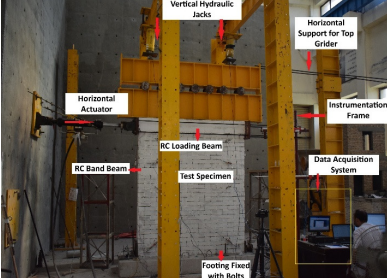Junaid Shah Khan, Azam Khan, and Tatheer Zahra
i PhD Scholar, National University of Sciences & Technology, Islamabad, Pakistan, jkhan.phd19nice@student.nust.edu.pk
ii Professor, National University of Sciences & Technology, Islamabad, Pakistan, azam.khan@nice.nust.edu.pk
iii Senior Lecturer, Queensland University of Technology, Brisbane, Australia, t.zahra@qut.edu.au
ABSTRACT
This study investigates the seismic performance of traditional mortar-bonded masonry and interlocking compressed earth brick (ICEB) masonry walls under lateral cyclic loading. An experimental program was developed to test full-scale specimens of both masonry types, assessing parameters such as initial stiffness, peak lateral resistance and lateral drift. The traditional mortar-bonded masonry wall constructed with first class bricks and 1:5 cement-sand mortar illustrated high initial stiffness but collapsed in a brittle manner. In contrast, the units of ICEB masonry wall made from a sustainable blend of sand, stone dust, and cement, with cavities grouted with 1:2:4 cement-sand-aggregate mixture demonstrated lower initial stiffness but significantly higher ductility and drift capacity, sustaining larger displacement without catastrophic failure.
KEYWORDS: brick-mortar walls, compressed earth blocks, ductility, lateral drift, seismic performance, structural resilience.
094-Khan.pdf



